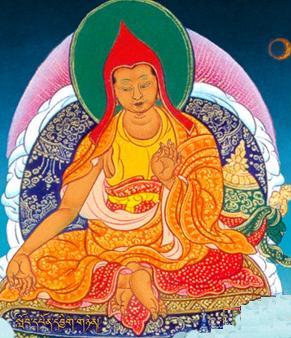Vasubandhu: Difference between revisions
No edit summary |
m (→His Disciples) |
||
| Line 20: | Line 20: | ||
==His Disciples== | ==His Disciples== | ||
He famously had four students who were more learned than himself: [[Sthiramati]], who was more learned in [[Abhidharma]]; [[Dignaga|Dignāga]], who was more learned in [[Pramana|Pramāṇa]]; [[Gunaprabha|Guṇaprabha]], who was more learned in the [[Vinaya]]; and [[Arya Vimuktasena]], who was more learned in [[Prajñaparamita|Prajñāpāramitā]]. | He famously had four students who were more learned than himself: | ||
*[[Sthiramati]], who was more learned in [[Abhidharma]]; | |||
*[[Dignaga|Dignāga]], who was more learned in [[Pramana|Pramāṇa]]; | |||
*[[Gunaprabha|Guṇaprabha]], who was more learned in the [[Vinaya]]; and | |||
*[[Arya Vimuktasena]], who was more learned in [[Prajñaparamita|Prajñāpāramitā]]. | |||
These students are not necessarily considered to be his direct students, but perhaps more in the sense that they followed in his lineage. | These students are not necessarily considered to be his direct students, but perhaps more in the sense that they followed in his lineage. | ||
Revision as of 09:59, 19 November 2018

Vasubandhu (Skt.; Tib. དབྱིག་གཉེན་, Yiknyen, Wyl. dbyig gnyen) (4th cent. AD) numbers among the ‘Six Ornaments’, the greatest Buddhist authorities of Ancient India. He was born in Cachemire and was the younger brother of Asanga. He composed the Treasury of Abhidharma, a complete and systematic account of the Abhidharma, the peak of scholarship in the Fundamental Vehicle. Later he followed the Mahayana Yogachara view, and wrote many works, such as Thirty Stanzas on the Mind.
His Writings
Vasubandhu was a prolific author and wrote texts on a wide variety of subjects, his most famous work being the Abhidharmakosha.
A set of eight texts are referred to as the Eight Prakarana:
- A commentary on The Ornament of the Mahayana Sutras
- A commentary on Distinguishing the Middle from Extremes
- A commentary on Distinguishing Dharma and Dharmata
- Well Explained Reasoning
- Treatise on Karma
- Analysis of the Five Skandhas
- Twenty Stanzas
- Thirty Stanzas
Other texts include:
- Sukhāvatīvyūhopadeśa (Skt.), a treatise on the Amitayurdhyana Sutra
- Treatise on the Three Natures
His Disciples
He famously had four students who were more learned than himself:
- Sthiramati, who was more learned in Abhidharma;
- Dignāga, who was more learned in Pramāṇa;
- Guṇaprabha, who was more learned in the Vinaya; and
- Arya Vimuktasena, who was more learned in Prajñāpāramitā.
These students are not necessarily considered to be his direct students, but perhaps more in the sense that they followed in his lineage.
Further Reading
- Stefan Anacker, Seven Works of Vasubandhu: The Buddhist Psychological Doctor, Motilal Banarsidass, 2nd Edition, 2002, ISBN 978-8120802032
- E. Lamotte, Karmasiddhiprakarana: le traité de l'acte de Vasubandhu, Bruxelles 1936
- J. Takakusu, The Life of Vasubandhu by Paramārtha, T'oung Pao
- Lobsang N. Tsonawa, Indian Buddhist Pandits from The Jewel Garland of Buddhist History, Dharamsala: Library of Tibetan Works and Archives, 1985.